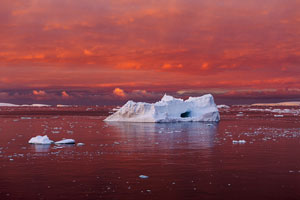To pick up from last time on “Coal + Ice at Asia Society, photographs out front document each step in the narrative, from coal to ice. Geng Yunsheng photographs Chinese miners dragging their burden across dry hills and at rest underground, with no certainty that they will ever see the light of day.
Camille Seaman has icebergs from both the earth’s poles, her photos saturated in blood red and ice blue. Gideon Mendel adds the consequences of climate change for India, where flooding has left homeowners literally underwater. Yet he means to show not despair but a return home. One man has begun to ladle out the water with a steel tub.
Is it a good start or a sadly comic ending? Such is the dilemma of climate change. A man in water up to his neck recalls a young black male popping up from a manhole in a classic photo (now in the Dean collection) by Gordon Parks, with much the same mix of comedy and fear. Parks himself puts in an appearance, with his own photographs of miners, as do Lewis Hines and Bruce Davidson, while shots of factory towers include Bernd and Hilla Becher. And here, too, something may sound all wrong. What is one to make of a group show of nearly forty artists, some who have never set foot in Asia?
A step inside provides a breathtaking answer. Credit the enormous photo and video collage to the curators, Susan Meiselas (a Magnum photographer in her own right, now on view at the International Center of Photography) and Jeroen de Vries. Identifying the contributors for each image is next to impossible, even with a plastic card just outside. If the show is flawed, it is less by dogmatism than by just that cinematic flash. As a poster upstairs asks, “What good is the house on the hill when the valley is on fire?” Here not just the landscape is fiery.
That poster belongs to one of a handful of special projects, which are immersive in a very different way: they serve as hopes for the future and actions for you, in the present. They can be as modest as a poem, by Jane Hirshfield, or as extravagant as a vision of New York in 2050, by Superflux. Make that two visions, of shortness of breath and long relief. They open with dark skyscrapers consumed in a deep red mist. And then a second chamber imagines a greener, wetter New York, with every boulevard now a waterway or a beach.
 Both chambers place you at their center, facing your own reflection in a mirror. It can be a proud or embarrassing encounter, and it is not the show’s final demand. Jake Barton sets out postcards with still more fiery, futuristic images—not just for your enjoyment, but for your signature on the back and an invitation to “chat with your future self.” Pull out your phone, text “The Accelerator,” and read what you can do in reply. Maya Lin is more welcoming still, with an interactive Web site for global climate information. Lin, whose credentials as an Asian American include her architecture for New York’s Museum of Chinese in America, has been committed to the intersection of art and climate change for some time.
Both chambers place you at their center, facing your own reflection in a mirror. It can be a proud or embarrassing encounter, and it is not the show’s final demand. Jake Barton sets out postcards with still more fiery, futuristic images—not just for your enjoyment, but for your signature on the back and an invitation to “chat with your future self.” Pull out your phone, text “The Accelerator,” and read what you can do in reply. Maya Lin is more welcoming still, with an interactive Web site for global climate information. Lin, whose credentials as an Asian American include her architecture for New York’s Museum of Chinese in America, has been committed to the intersection of art and climate change for some time.
Their technology leaves what once were “new media,” in Asian video and photographs, in the dust. Still, for all their optimism, the projects raise their own doubts for the future. Has New York in 2050 converted automobile traffic into a day at the beach, or has it made the best of rising seas? Jamey Stillings takes his video camera to renewable energy, but the windmills look eerily close to white crosses in the mega-video a floor below. Clifford Ross, whose questions about climate line the stairs, headed straight for the New York coast for a hurricane—a seeming tidal wave aimed at him. “Coal + Ice” wants to supply an antidote to fire and despair, but neither is all that far away.
Read more, now in a feature-length article on this site.
